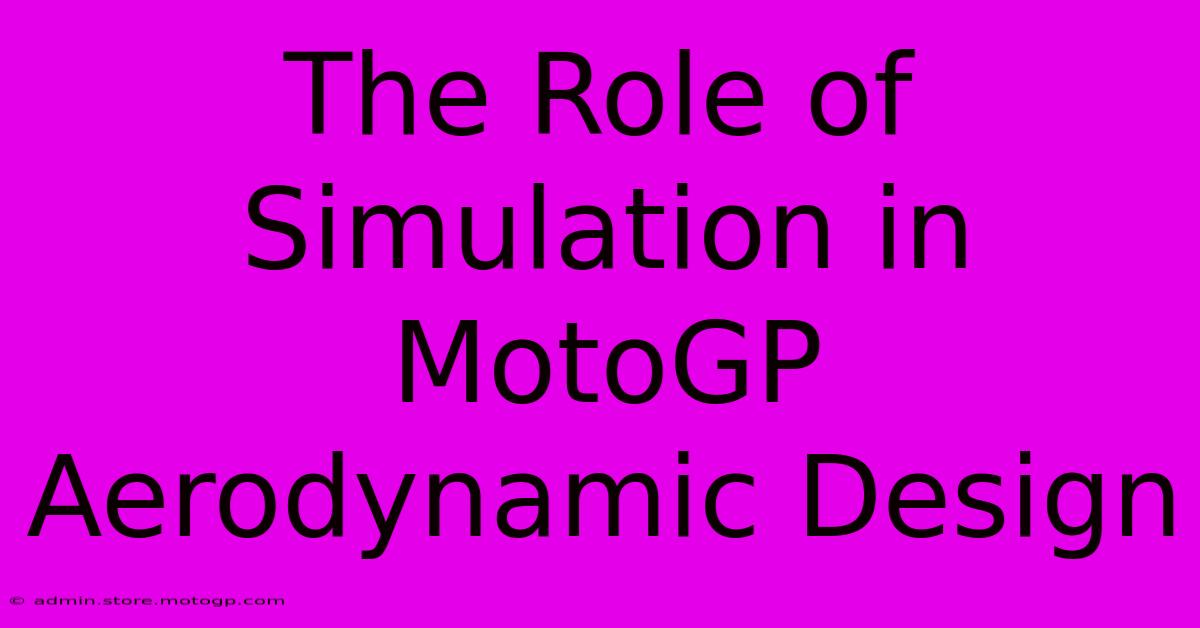The Role Of Simulation In MotoGP Aerodynamic Design

Table of Contents
The Role of Simulation in MotoGP Aerodynamic Design
MotoGP, the pinnacle of motorcycle road racing, is a relentless pursuit of speed and performance. Every millisecond shaved off lap times translates to victory, and aerodynamic design plays a crucial role in achieving this. While wind tunnel testing remains vital, Computational Fluid Dynamics (CFD) simulation has emerged as an indispensable tool, revolutionizing how teams approach aerodynamic development. This article delves into the significant role simulation plays in shaping the cutting-edge aerodynamics of MotoGP machines.
Understanding the Importance of Aerodynamics in MotoGP
Before exploring the intricacies of simulation, it's crucial to grasp the significance of aerodynamics in MotoGP. At high speeds, aerodynamic forces significantly impact a motorcycle's performance. These forces include:
- Downforce: This is the force pushing the motorcycle downwards, increasing grip and stability through corners, especially at high lean angles. More downforce allows riders to push harder on the brakes and accelerate earlier out of corners.
- Drag: This is the resistive force that opposes the motorcycle's motion, slowing it down. Minimizing drag is vital for maximizing top speed on straights.
- Lift: This upward force can destabilize the motorcycle at high speeds, particularly on jumps or uneven surfaces. Minimizing lift is crucial for maintaining control.
The delicate balance between maximizing downforce and minimizing drag is the key challenge for aerodynamic engineers. This is where simulation steps in.
The Power of CFD Simulation in Aerodynamic Design
CFD simulation utilizes sophisticated software to model the airflow around a virtual motorcycle. By solving complex equations that govern fluid motion, engineers can visualize and analyze the airflow patterns, pressure distribution, and resulting aerodynamic forces. This provides invaluable insights that were previously difficult, if not impossible, to obtain through physical testing alone.
Benefits of CFD Simulation:
- Cost-effectiveness: CFD simulation is significantly cheaper than extensive wind tunnel testing. Multiple design iterations can be explored virtually, reducing the overall cost of development.
- Speed and efficiency: Simulations can be run much faster than physical tests, allowing engineers to explore a wider range of design options in a shorter time.
- Detailed analysis: CFD provides a wealth of data, offering a far more detailed understanding of airflow than traditional methods. This allows for precise adjustments to optimize performance.
- Accessibility: Simulation allows for the exploration of extreme conditions and scenarios that might be difficult or impossible to replicate in a wind tunnel.
Specific Applications in MotoGP Aerodynamics:
- Winglet Design: Simulation is instrumental in optimizing the design and placement of winglets, crucial for generating downforce. Engineers can test various shapes, sizes, and configurations to maximize downforce while minimizing drag.
- Fairing Optimization: The motorcycle's fairing significantly impacts airflow. Simulation helps engineers refine the fairing shape to minimize drag and manage airflow around the rider and other components.
- Rider Interaction: Simulations can incorporate the rider's position and movements to accurately model the complex interaction between the rider and the airflow. This is critical for accurately predicting performance.
- Chassis Integration: The design of the chassis and its interaction with the airflow also impacts the overall aerodynamic performance. Simulation allows engineers to test and refine this integration.
CFD Simulation and the Future of MotoGP Aerodynamics
CFD simulation is continually evolving, with advancements in computing power and software leading to increasingly accurate and sophisticated simulations. This leads to more refined aerodynamic designs, translating to faster lap times and improved rider performance. The integration of machine learning and artificial intelligence is further enhancing the process, automating design optimization and accelerating development cycles.
In conclusion, CFD simulation has become an indispensable tool in MotoGP aerodynamic design, enabling teams to push the boundaries of performance and achieve previously unimaginable levels of speed and efficiency. As technology continues to advance, the role of simulation in shaping the future of MotoGP will only become more significant. The relentless quest for speed demands constant innovation, and simulation is at the forefront of this innovation.

Thank you for visiting our website wich cover about The Role Of Simulation In MotoGP Aerodynamic Design. We hope the information provided has been useful to you. Feel free to contact us if you have any questions or need further assistance. See you next time and dont miss to bookmark.
Featured Posts
-
Cota Parking Doesnt Have To Be A Headache Choose Lot R
Feb 18, 2025
-
The Ultimate Expression Of Fandom Replica Helmets
Feb 18, 2025
-
F1 Weekend Austin Plan Your Trip Today
Feb 18, 2025
-
Moto2 Motorcycles A Symbol Of Racing Excellence
Feb 18, 2025
-
Cota Grandstands Where Legends Are Made
Feb 18, 2025
